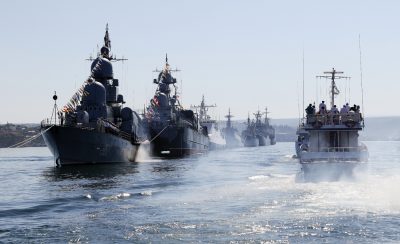In July it was reported that Russian President Vladimir Putin had fired the entire leadership of his Baltic Fleet, a purge on a scale not seen since Stalin’s bloody purges of the 1930s.
At that time Stalin decapitated his army and navy, killing most senior officers. It has often been said that the Germans concluded that the huge Soviet military machine was no longer likely to be effective, hence that a quick invasion of the Soviet Union could succeed. It failed, but by a narrow margin, and at a horrific human cost to the Soviets. Putin’s purge has not, at least as yet, extended to imprisoning or killing the officers involved. Instead, their forced retirement has been justified by charges of incompetence. It seems more likely that the officers involved had refused to engage in risky behavior Putin is now demanding. He has cancelled the Cold War agreement to limit incidents at sea; he wants to show the Baltic countries that his navy is not ‘afraid’ of pushing back against any U.S. or NATO presence there.
The most dramatically provocative Russian behavior has been high-speed passes by attack aircraft near U.S. warships operating legitimately in the Baltic Sea. Russian officers are probably uncomfortably aware of how dangerous that is – to their own aircraft. It is particularly dangerous given the age of many of the aircraft and, almost certainly, their limited state of repair. It is one thing to display dramatic photographs of an Su-24 buzzing a U.S. ship, but quite another explaining the loss of such an airplane as it plunges into the sea. This is not an idle prospect; in 1968 a Soviet ‘Badger’ overflew USS Essex at too low a level and cartwheeled into the sea, killing all on board. The difference is that in 1968 the Soviets had many ‘Badgers’ and the loss was not very important. Now that Russian aircraft production is nearly moribund, losses are much less tolerable in any real military sense.
Presumably the buzzing is part of a larger campaign to roll NATO back from the three Baltic republics, and ultimately to overrun them. That in turn would be part of Putin’s larger program of restoring all territory once held by the Soviet Union. The three Baltic republics were once semi-independent Czarist territory. They fought for and won their independence after World War I, and retained it until Stalin invaded in 1940, under an agreement with Hitler. Many in the Baltics have very bitter memories of Russian occupation and the attempt to suppress their own nationalities. The Baltic republics led in the movement to dissolve the Soviet Union. About 1990 President Putin discovered that the only way to keep them in the Soviet Union was by force, and he could not do that. For similar reasons he and other Russians could not suppress Poland. Thus the Baltic republics are the symbol of freedom arising out of the ashes of the old Soviet Union, and at the same time a reminder of the collapse of the Soviet Union, a source of shame which President Putin wants to wipe out.
The sense of victimization is vital to President Putin. He maintains his power by playing to a strong sense of victimization among Russians, many of whom resent the collapse of the Soviet empire without any war. They cannot imagine that the collapse was self-induced, that without economic strength their country could not possibly have maintained its vast and wasteful military machine. Some have called President Putin a ‘media dictator,’ relying on mass media, particularly television, to dramatize both the corruption of the West and its constant attack on Russia. This is not an attempt to revive Communism, which Putin rightly understands was already moribund when the Soviet Union collapsed. It is an appeal to the more basic instincts of Russian nationalism and envy of the West (which often turns into a claim that Russia has a superior spirituality opposed to Western materialism). The combination of nationalism, envy, and a spiritual appeal is nothing new; it was used by the Czars before World War I. Anyone who wants a taste of current Russian television can watch the cable channel Russia Today, with its cynical view of the West and particularly of Western democracy. Russia’s ‘heroic’ resistance to Western ‘pressure’ is highlighted, and of course there is no sense that the Russians are attacking perfectly legitimate Western rights. Thus, for example, the Russian invasion of Ukraine becomes a legitimate defense of Russians against a corrupt Ukrainian regime.
Looking back at World War I, President Putin talks of how victories achieved by the Russian army of the time were squandered and denigrated. He carefully avoids explaining that the squanderers and subversives were the Bolsheviks who created the state which in turn created him. Nostalgia for the imperial power of the Soviet Union is apparently not tempered by memories of the gross squalor of life at that time. Nor is the memory of mass imprisonment kept alive, at least by the state. Stalin is increasingly a hero, his monstrous aspects either forgotten or actually admired as proof of his strength.
Putin has shown considerable interest in attacking the West politically. He apparently has no interest in existing left-wing political parties, which he rightly judges are largely powerless and are most unlikely to succeed. Instead, he is investing in the rising populist movement in the West (after all, he can be described as a populist). For example, he provided financial backing to the French National Front (led by Marie Le Pen), judging that its isolationist stance would help destroy NATO. He seems to have backed a Dutch referendum attacking an EU trade agreement with Ukraine. Most of those voting against the agreement apparently saw the referendum as a way to express their dissatisfaction with the current Dutch and EU governments rather than as a specific vote on a specific issue. For its part, the EU has done very little to assuage populist concerns. It largely follows a social agenda, led by France and Germany, which favors workers who already have jobs but also drastically limits growth so that those out of work stay out of work (words like ‘competitive economics’ are deeply disliked). In France in particular, that has meant very high unemployment, and a recent general strike by unions unwilling to surrender any of their rights. Without much growth, the economic pie cannot expand to provide both what the unions want and what the unemployed want. The current French government has made very little attempt to explain as much, and its pro-growth measures are less than inspiring. This EU agenda, incidentally, helps explain the British vote to leave the EU. It certainly paralleled Putin’s anti-EU/anti-NATO agenda, but it does not seem to have been influenced by Putin. The Dutch and French cases are different.
Putin’s demonstrations in the Baltic and his support for the anti-NATO parties are parts of a coherent strategy designed to overcome the main Russian problem, a drastic lack of military power due to economic problems Putin cannot or will not address. The Soviet Union crashed not because the West overran it, but because it could not sustain its level of military investment, which some estimated was as high as half its economic product. Pouring resources into the military caused worsening poverty and in turn eliminated the incentive to work. The governing Party skimmed what surplus there was, just as the current oligarchs skim much of the cash in Russia. In each case, skimming (pervasive corruption) is the price the government has to pay to gain political loyalty.
What has happened since the collapse of the Soviet Union is that the cost of running Russia has risen; in a conventional economy people have to be paid with real money which can buy real goods. Mr. Putin can use his nationalist myth to inspire Russians to sacrifice, but not on the scale of the old Soviet Union. Without a robust economy, he has relatively little money left over for the military, let alone for military expansion. That is why his army now concentrates on the use of limited numbers of elite troops, and why he substitutes gross violations of past agreements for real naval power in the Baltic. The reality is that the damage done when the Soviet Union came apart has not been repaired. It has taken fourteen years to complete the new destroyer Admiral Gorshkov, and the Russians are still unable to produce new gas turbines for such ships. The ship’s air defense system, which the Russians claim is equivalent to the U.S. Aegis, is designed to track all of sixteen targets simultaneously. Aegis was doing more than ten times as well more than thirty years ago. The 9M96 missile is now considered effective out to 40 km (21.6 nautical miles), which is far short not only of its design capability but also of what Aegis could do in the 1970s.
The failures of the system on board the Admiral Gorshkov have wide implications. They have been attributed in part to the poor condition of the Fakel design bureau, which is responsible for the missile and is said still to be using Soviet-era tools and facilities. Fakel’s missiles are also part of important Russian land-based systems, such as the much-touted S-300, S-400, and S-500, some of which have been exported to places like Iran. It is most unlikely that clients have actually tested the systems themselves; they have relied on advertising by the Russians. Failures of Russian missile systems suggest that the export of these systems to the Middle East may not be the game-changer which has been advertised. Accounts of the systems generally describe sophisticated command and control techniques, but without seeing the systems in action it is impossible to say how well they actually work. When the Russians shot down a Malaysian airliner (Flight MH-17) over Ukraine, they were demonstrating that one of their earlier systems worked – and that it was unable to distinguish between multiple targets. How would the system have functioned in the face of decoys?
That the Admiral Gorshkov system can track sixteen targets at the same time might once have seemed very impressive, but the real question is how well it can distinguish one or two real targets from a cloud of decoys. It will not help the system if the real targets have small radar cross-sections and the decoys have larger ones. In Putin’s world of public relations-based reality, none of that matters – unless we begin to realize that what the Russians say about their more or less new (often actually Soviet-era) weapons and how well they can function may not have much in common.
 * Norman Friedman is author of The Naval Institute Guide to World Naval Weapon Systems. His column is published with kind permission of the US Naval Institute.
* Norman Friedman is author of The Naval Institute Guide to World Naval Weapon Systems. His column is published with kind permission of the US Naval Institute.




